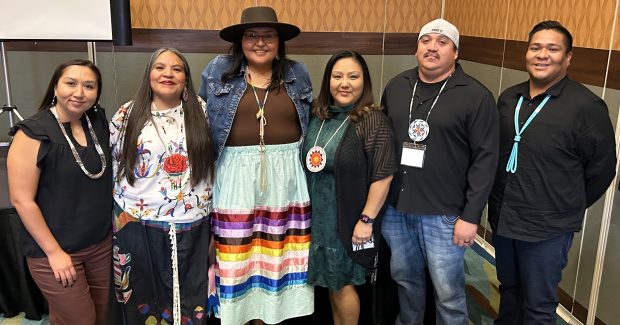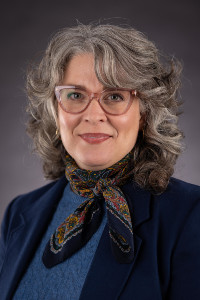POCATELLO — At Idaho State University, Laticia Joyce Herkshan has been in classrooms where she was openly mocked for being Native American, where peers have described the Fort Hall reservation — her home — as ‘trashy’ and ‘dangerous’, and where one classmate argued that the United States should not apologize for “the genocide that was committed on Native people.”
“So, I don’t think the campus climate is very welcoming,” Herkshan said. Herkshan is an undergraduate advisor and mentor in Idaho State’s geosciences department. She’s also an Idaho State alumnus.
She was one of six Shoshone-Bannock tribal members who described their experiences as current or recent Idaho State students at the Shoshone-Bannock Casino Hotel on Saturday. The panel was part of the Western Literature Association conference, which brought academics from around the country to the Fort Hall reservation to discuss tribal sovereignty and sustainability. Idaho State students and Shoshone-Bannock tribal members were also invited to attend.
The panelists said they were often misunderstood or unseen at Idaho State, and called on the university’s education leaders and professors to learn about, listen to, and recognize Indigenous communities and students.

“We have leaders who are horrifically uninformed about the tribes,” Herkshan said, adding that it’s frustrating because professors and university administrators are experts at learning.
Panelists said professors and teachers also need to recognize the unique knowledge that Indigenous students carry. Too often, educators approach Native students with the attitude that they need to “lead us out of whatever under-education we have,” Herkshan said. “Many students come to the classroom with so much experience and knowledge different from white students’, and it’s not acknowledged, it’s not praised, it’s not honored.”
“Come at (Indigenous students) like equals and know that they might not have a degree, but they do know a lot of things,” said Zachery Wadsworth, wetlands and nurseries manager for the Shoshone-Bannock Tribes’ fisheries program.
Shoshone-Bannock students have faced other barriers at Idaho State, too — like an ineffective tribal advisory board, a disconnect between the tribes and the university, and advising that wasn’t tailored to Native students’ needs.
Idaho State’s tribal advisory board is comprised of Idaho State staff and Shoshone-Bannock tribal members and aims to strengthen relationships between the two entities and enrich educational opportunities for tribal students. But Herkshan said the advisory board “has no teeth” and “there is nothing that holds them accountable.”
“We don’t know who they advise. Are they advising each other? Because they don’t often speak with the university president,” she said.
Native American students are also made to feel invisible because there are few celebrations of their culture on campus, and because many Shoshone-Bannock students do not live on campus. Instead, many commute in from Fort Hall, Dana Edmo-Hernandez, the manager for the tribal youth education program and a former Idaho State student, said.

Plus, as multiple panelists noted, most staff members and students don’t make the effort to come to the reservation — to watch powwows or participate in other events — and see Shoshone-Bannock students in their element and where they’re most comfortable. And that means non-Native faculty and staff don’t get that humbling “role reversal” of feeling uncomfortable in a place where they’re the minority, Angela Marie Eldredge, a teacher at Chief Tahgee Elementary Academy and former Idaho State student, said.
There’s more that staff could do, too — like encouraging Shoshone-Bannock students to earn an associate’s degree, instead of just pushing a bachelor’s. An associate’s can help Native American students stay in school because in just two years, they earn a degree, Marquette Bagley, big game and wildlife program manager for the tribes’ fish and wildlife department, said. That more immediate reward can entice students to stay enrolled in college.
Amanda Zink, an English professor at Idaho State and the panel’s moderator, also said that many Idaho State professors could take a cue from Indigenous culture — where often, relationships matter more than progress or power.
“We need to move away from hierarchy and toward relationships for their own sake,” she said.
Then there’s the matter of curriculum. Zink asked panelists how it feels to learn in a state where there’s been a “campaign against diversity” and attempts to “whitewash state history.”
“We are a part of the history of the U.S., before (it became a nation), during (the revolution) and even now,” Terrance Jay Tso, who works for the tribes’ community development financial institution and the tribal housing opportunities program, said. “We’re just going to have to keep fighting (to get Indigenous perspectives in the curriculum) and keep talking and make sure our voices are heard.”
Tso has introduced himself as Native American in classes before — which he often does because people otherwise assume he’s Mexican — only to have classmates come up to him afterward in surprise: “(Native Americans) are still here?”
“When it comes to the curriculum, and just everything, Native Americans are always an afterthought,” Tso said. “We’re just forgotten.”
Further reading: Take a look at our series on how tribes are fighting to be seen in Idaho classrooms, and more coverage on the conference — including its keynote speaker, a renowned journalist, visiting a tribal high school and tribal leaders calling on the education community to do more for Native students.
